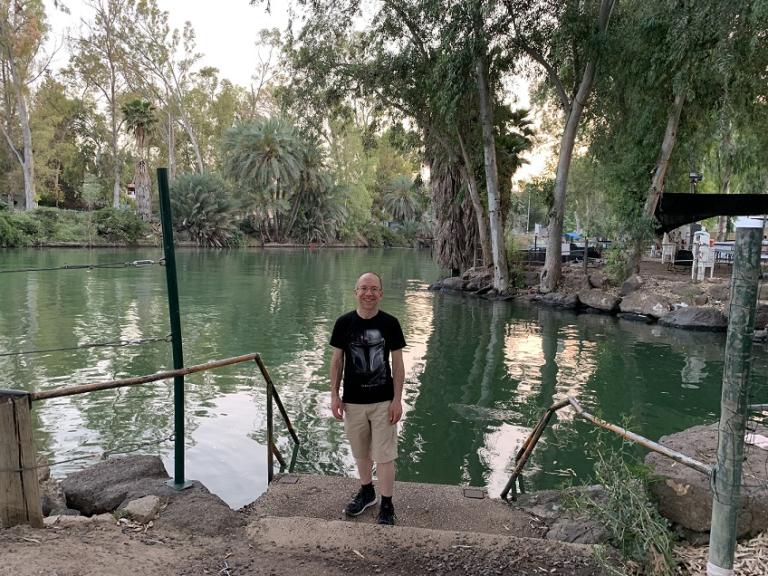In 2012 the Israel Nature and Parks Authority began new works under the authority of the Civil Administration, and two weeks ago a newly restored, impressive Samaritan residential compound was open for visitors, enabling them to experience history by walking through the ancient rooms.The compound, dated at around 200-300 BCE, is part of a large city from the Persian and Hellenistic periods which was built around a sacred precinct where once stood the Samaritan Temple, and where today stands the remains of a large Byzantine church built on top of the destroyed Temple, a heavy wall cutting right through the holy Samaritan site where Samaritan tradition holds the Tabernacle stood. During the Muslim period a military guard post was built over one of the church’s towers.The archaeological remains go back about 2,400 years, said site director Netanel Elimelech, with the remains of the Samaritan Temple from the Persian era the oldest.
Samaritans
| ࠔࠌࠓࠉࠌ שומרונים السامريون | |
|---|---|
 Samaritans marking Passover on Mount Gerizim near Nablus | |
| Total population | |
| ~840 (2021)[1] | |
| Regions with significant populations | |
| 460 (2021)Total [sic] in 2021 - 840 souls[1] Total in 2018 – 810 souls[1] Total number on 1.1.2017 - 796 persons, 381 souls on Mount Gerizim and 415 in the State of Israel, of the 414 males and 382 females.[1] | |
| 380 (2021)[1] | |
| Languages | |
| Modern spoken languages: Israeli Hebrew, Levantine Arabic Liturgical languages: Samaritan Hebrew, Samaritan Aramaic | |
| Religion | |
| Samaritanism | |
| Related ethnic groups | |
| Jews; other Semitic-speaking peoples (Levantine Arabs, Mandaeans, etc.) | |
| Part of a series on |
| Samaritanism |
|---|
 |
Samaritans (/səˈmærɪtənz/; Samaritan Hebrew: ࠔࠠࠌࠝࠓࠩࠉࠌ,[3] romanized: Šā̊merīm, transl. Guardians/Keepers [of the Torah]; Hebrew: שומרונים, romanized: Šōmrōnīm; Arabic: السامريون, romanized: as-Sāmiriyyūn) are an ethnoreligious group whose traditions affirm they descend from the ancient Israelites. They are native to the Levant and adhere to Samaritanism, an Abrahamic and ethnic religion.
Samaritan tradition states that they descend from the northern Israelite tribes who were not deported by the Neo-Assyrian Empire after the destruction of the Kingdom of Israel. They believe that Samaritanism is the true religion of the ancient Israelites, preserved by those who remained in Palestine during the Babylonian captivity;[4] this belief is held in opposition to Judaism, the ethnic religion of the Jewish people, which Samaritans see as a closely related but altered and amended religion brought back by Judeans returning from Babylonian captivity. Samaritans consider Mount Gerizim (near both Nablus and biblical Shechem), and not the Temple Mount in Jerusalem, to be the holiest place on Earth.[5][6]
Once a large community, the Samaritan population shrunk significantly in the wake of the bloody suppression of the Samaritan Revolts against the Byzantine Empire (mainly in 525 CE and 555 CE). Mass conversions to Christianity under the Byzantines, and later to Islam following the Arab conquest of the Levant, also reduced their numbers significantly.[7] In the 12th century, the Jewish traveler Benjamin of Tudela estimated that only around 1,900 Samaritans remained in the regions of Palestine and Syria.[8]
As of 2022, the total Samaritan population stands at less than 1,000 people. The Samaritan community is divided between Kiryat Luza on Mount Gerizim and the Samaritan compound in Holon.[b][10] The head of the community is the Samaritan High Priest. Samaritans in Holon primarily speak Israeli Hebrew, while those in Kiryat Luza speak Levantine Arabic; for the purposes of liturgy, the languages of Samaritan Hebrew and Samaritan Aramaic are used, written in the Samaritan script. There are also a small number of Samaritans living outside the Levant, in Brazil and in Catania (Sicily), Italy. [11]
Samaritans have a standalone religious status in Israel, and there are occasional conversions from Judaism to Samaritanism and vice-versa, largely due to interfaith marriages. While Israel's rabbinic authorities came to consider Samaritanism to be a sect of Judaism,[12] the Chief Rabbinate of Israel requires Samaritans to undergo a formal conversion to Judaism in order to be officially recognized as Halakhic Jews. Rabbinic literature rejected Samaritans unless they renounced Mount Gerizim as the historical Israelite holy site.[c] Samaritans possessing only Israeli citizenship in Holon are drafted into the Israel Defense Forces, while those holding dual Israeli and Palestinian citizenship in Kiryat Luza are exempted from mandatory military service.
This is an extensive article. The remainder of it may be found here:
https://en.wikipedia.org/wiki/Samaritans








